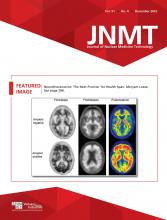With coronavirus disease 2019 (COVID-19) numbers projected to rise in the coming months, institutions may once again need to assess the current criteria for accepting and performing the ventilation portion of a ventilation/perfusion (V/Q) lung scan (1). This invited perspective focuses on the updated Society of Nuclear Medicine and Molecular Imaging (SNMMI) statement for V/Q lung studies: “SNMMI believes that…V/Q…lung scans are safe to perform when local regulatory and institutional standard procedures and guidelines are followed. Similarly, if a patient is suspected of having or has confirmed COVID-19 or if [there is] a surge in COVID-19 cases or other serious respiratory illness, then it is imperative in such scenarios to stay vigilant and follow your local policies and procedures regarding patient and staff safety precautions and protocols” (2).
Historically, V/Q lung scans played a leading role in diagnosing pulmonary emboli and assessing airway disease. In today’s clinical environment, on the basis of image quality and accuracy for pulmonary embolus detection, CT pulmonary angiography is the most commonly ordered diagnostic tool to assess pulmonary emboli. However, with the significant improvement in V/Q lung sensitivity and specificity due to SPECT and SPECT/CT, along with the information obtained about chest pain and lung disease, including vascular and airway disease, V/Q scans continue to be a vital diagnostic tool (3).
The original SNMMI statement, as published in 2021, recommended a review of institutional guidelines, including a facility’s policies and procedures for the performance of V/Q lung scans (4). With the threat of a COVID-19 resurgence in the winter, clinical sites will benefit from a careful review of the following suggested recommendations and added context.
First, consideration should be given to a COVID-19 polymerase chain reaction test, depending on local policies or institutional guidelines. In some clinical environments, institutional guidelines may require a negative COVID-19 test before the performance of a ventilation lung scan. Institutional guidelines should clearly describe inpatient and outpatient testing, as well as the timelines and reporting of COVID-19 tests. In patients who have had a positive COVID-19 polymerase chain reaction test, the patient may test positive for weeks or even months. Facilities should follow their institution’s clinical guidelines for recovered patients who previously tested positive for COVID-19 (5).
Second, when performing ventilation studies, technologists should wear appropriate personal protective equipment in accordance with local policies. A comprehensive review of the appropriate selection and use of all personal protective equipment is recommended for every staff member with patient contact. The safe use of N95 masks requires individual fitting and testing and, in some institutions, annual refitting.
Third, the airflow of the room in which the ventilation studies are performed should be evaluated, which may help to determine the required time for room turnover after the performance of a ventilation study. For imaging room safety, the preferred airflow between patients is 6–12 room air exchanges/hour. Air exchanges/hour is the full replacement of the volume of air filling a room. Building maintenance staff can provide assessment and verification data on air exchange for the room in which the ventilation study will be performed. Depending on the agent used for imaging, an imaging room may also require negative air pressure. However, after a COVID-19–positive patient is ventilated and imaged, adjustments must be made to the imaging schedule to ensure that adequate air exchanges and terminal room cleaning is provided. For most facilities, this will require an additional 60–90 min after the lung scan.
Fourth, the selection of the appropriate agent for the ventilation study should be carefully considered. The ventilation agent should be the one that provides the best clinical quality while also minimizing the technologist’s exposure to particulates that may emanate from the patient. As such, the ultrafine microaerosol of 99mTc-Technegas (Cyclomedica Ltd.) is the agent that best minimizes staff exposure since it only requires minimal time (2–3 short puffs). Of note, 81mKr also provides for minimal exposure risk for technologists; however, it is not available in the U.S. but is widely used in Europe and Australia. At the writing of this article, 99mTc-Technegas was just recently FDA approved (September 29, 2023; https://www.snmmi.org/NewsPublications/NewsDetail.aspx?ItemNumber=45004) and may not be readily available. Aerosolized products, including 99mTc-diethylenetriaminepentaacetic acid, are reported to pose the highest risk for exposure and contamination. Noble gases (e.g., 133Xe and 81mKr) are reported to pose a smaller risk due to the limited time of staff exposure and a room’s negative air pressure. Additional safety recommendations can be found in the manufacturer guidelines for the delivery system.
Fifth, local infection control groups should be engaged for guidance and to help evaluate facilities, equipment, and staff personal protective equipment necessary to safely perform ventilation studies. Institutional and regulatory guidelines require an annual review of a clinic’s policies and procedures associated with infection control. A secondary department refresher may be of value for specific practices associated with staff and patient safety for ventilation studies.
Finally, the approach to performing a ventilation scan in relation to the perfusion scan (i.e., ventilation then perfusion vs. perfusion then ventilation) should be considered according to the clinical indication, and consultation with the referring physician may be advisable. Interpreting physicians should work closely with referring physicians to develop specific criteria for the ordering and performance of a V/Q lung scan. Ordering criteria and related performance of V/Q lung scans should be clearly explained or reviewed with nuclear medicine staff.
As the winter season approaches with its inevitable rise in respiratory diseases, including COVID-19, V/Q lung scans can continue to provide an accurate assessment of vascular and airway lung disease in a safe environment when clinical sites adhere to local regulatory and institutional standard procedures and guidelines.
DISCLOSURE
No potential conflict of interest relevant to this article was reported.
REFERENCES
- Received for publication September 22, 2023.
- Accepted for publication September 22, 2023.







